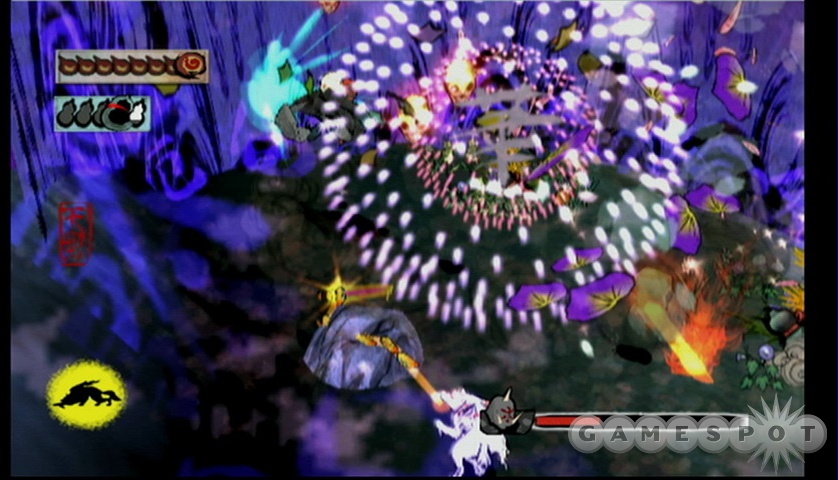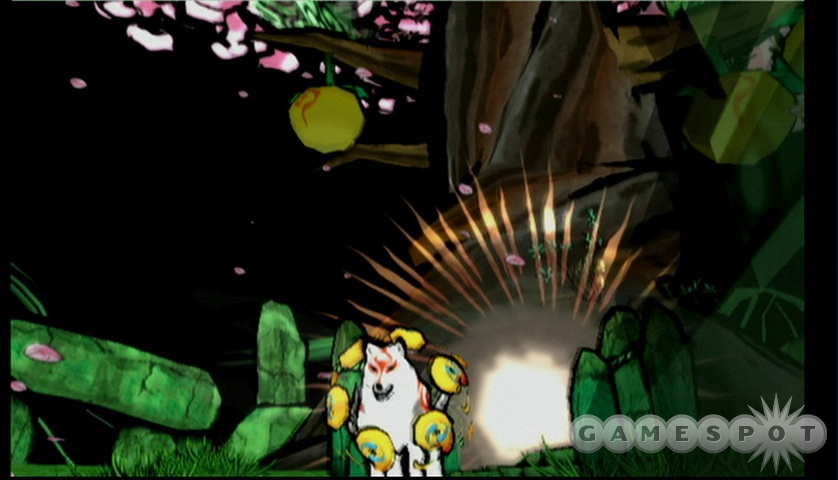There's a blissful moment in the first hour of Okami, one that is repeated several times throughout the game's epic tale: Tasked with restoring an afflicted sapling to its former beauty, you bring it to life with a swirl of your virtual paintbrush. The sapling bursts with light, a melody of soft pink flowers blooms on its young branches, and lush green meadows breathlessly sweep away the cursed countryside, returning vitality to the diseased landscape. It's a moment that stays with you, and it represents the sheer joy of playing Okami. Few games exude such grace and visual prowess, though you shouldn't assume that its beauty is superficial. Here is a case where stunning graphics, charming characters, and a dreamy, mythical adventure are united into a cohesive, powerful title that simply must be played. If for some reason you didn't catch it in 2006 on the PlayStation 2, you should do so now, posthaste.
Okami's story is straightforward, but it draws you easily into its world of mythical beasts and sake-swilling charlatans by way of smart, funny dialogue and a number of charming characters to chuckle at. As the goddess Amaterasu, who has been reborn in the body of a white wolf, you work to rid Nippon of the evil eight-headed serpent called Orochi and renew the lands it has poisoned. Ammy is a silent heroine, but that's just fine, since your energetic, buglike companion Issun does plenty of talking for the both of you. There is a lot of dialogue to sift through, and since the characters just speak a chirpy brand of gibberish, you'll be doing a good bit of reading. You can skip past it and get right back into the action if you so desire. If you did this, however, you'd be missing out on many of Okami's humorous exchanges, such as those with a heavyset sparrow that can only be described as the Godfather's avian counterpart.

You will notice right away that visually speaking, Okami resembles no other game that has come before it: It looks like a watercolor painting come to life. Landscapes are drawn with broad strokes and colors have a slightly muted tone, as if the paint has seeped a bit into the canvas. In locations like Kamiki Village, rose-hued blossoms waft past, while the subdued greens and grays of cursed zones make those areas feel stifled and foreboding. As Amaterasu, you leave a small trail of grass blades and flower petals behind you, which signifies the brilliance you seek to restore. Fans of the PlayStation 2 version may notice that the canvas filter in the Wii iteration is less noticeable, though it hasn't been removed entirely. Yet on a widescreen, high-definition display, Okami is dazzling, so while some may prefer the PS2's slightly softer look, the game's vistas are even more magnificent on the Wii. There are few instances in games that compare to watching a tree that was near death bloom before your eyes, or watching Amaterasu's lithe form sprint across the green terrain. The frame rate slows a bit here and there, and there are some brief loading times when you cross into new areas, but they are insignificant nitpicks that don't hinder the game's artistry.
That visual beauty is matched by a stupendous sound design that enhances the onscreen events and makes Okami a feast for the senses. Battles are signaled by the thumping of drums and the whistle of a wooden flute. The spread of petals and leaves is accompanied by the strums of harps. When you talk with some of the more quirky characters, bassoon and clarinet riffs complement their rants. The emotional range of the soundtrack parallels the pervading sentiment in any given scene or battle, so while it's easy to heap praise on the unique visual style, the soundtrack and sound effects are equally extraordinary.
Not that Okami is simply a work of art meant to be hung on a wall and admired from a distance. It's also a long adventure game with some interesting gameplay mechanics that are woven into the production values so well that one aspect couldn't thrive without the other. You'll travel from one end of Nippon to the other, speaking with all sorts of eccentrics and taking on a number of quests. Often, you'll need to fight, though much of the time, you can simply avoid enemy encounters, which are represented on the screen by floating scrolls and miniature haunted houses. When you do battle, you'll face any number of surreal foes, from flying fish to drum-beating demons, along with a few imposing-looking boss creatures. You can equip a number of different weapons, and you'll generally have primary and secondary attacks available to you. Combat is fun and moves along quickly, and it looks terrific.
The standard combat controls take some time to get used to. Weapons like the life beads work remarkably well, doing plenty of damage with a forward flick of the Wii Remote. Standard reflectors, on the other hand, may cause you frustration at first, because you can't string attacks together simply by incessantly flinging your remote forward and back. Rather, you need to time subsequent attacks, or your thrusts won't respond as you'd expect. This is one area where the PlayStation 2 version has the upper hand. Certain weapons simply aren't suited to be your primary attack in the Wii version, since the timing of your slicing and dicing is tough to get a handle on. Another area that needs improvement is dodging. On the Wii, you yank the Nunchuk in the direction you want to tumble. The problem is that Ammy may or may not dodge in that direction. In Okami, this isn't a big problem; combat is easy, so you'll rarely need to dodge. In fact, you may even forget you have the option in the first place. Nevertheless, dodging is troublesome, and folks who want to use Infinity Judge or Tsumugari as their primary weapons will need to adjust to picky motion controls.
On the flipside, the Wii controls shine brightly in regards to the celestial brush. You can pull out the brush at any time and use it to slash through demons, create gusts of wind, draw bombs, create impromptu waterspouts, and perform all sorts of sundry tasks. This is Okami's main gameplay conceit, and it's woven impeccably throughout the game, where it's utilized in battles, puzzle sequences, and even some cute minigames. On the PS2, you used an analog stick to draw the necessary rune; on the Wii, of course, you use the remote. For the most part, this works wonderfully. Interacting with the celestial brush in this manner is incredibly pleasing, since you literally draw the motions onto the screen. It also improves the pace of the game, because you can scrawl at a faster rate. Using the remote in this manner has its foibles, particularly when you need to draw a straight line. However, ineffective scrawling can be easily corrected with a second try and a careful hand.

All in all, the motion controls give the Wii version a slight advantage, by greatly enhancing the brush aspect of Okami while contributing to some minor flaws in basic combat. But you'll also be accomplishing a variety of other tasks on your travels, and these peripheral elements are arguably what make the game so exceptional. You'll need to earn praise if you wish to increase your total health or the amount of ink your brush will hold. To do so, you can bring a withered tree back to life, which always produces a lovely flourish of colors and sonic textures. Feeding various animals you encounter will also benefit you. Different fauna require different types of food, but assuming you have what your furry friends prefer, you'll be rewarded with your due praise and a gentle cutscene showing your follower enjoying his morsel.
These elements all coalesce into a completely engaging experience that's almost impossible to walk away from. You'll hurtle down a river at breakneck speed on a runaway log, and slow it by drawing makeshift vines with the celestial brush. You'll search for hidden treasure in a sunken ship, siphon flames from a fiery foe to defeat an icy one, and get an eight-headed monstrosity drunk with holy sake. None of these tasks are very challenging, but the variety of gameplay, and the stylishness with which it's presented, will push you forward--and just when you think you've reached the end, there's more to the saga. It will take most speedy players a minimum of 30 hours to gun through Okami, though you'll probably be inclined to savor the experience, digging up every hidden clover and finding all of the game's many secrets and treasures.
Age isn't kind to many games, but with the addition of motion controls for the celestial brush and support for widescreen and progressive scan displays, Okami has been updated enough to make it even more relevant today than it was in 2006. At a time when the majority of action games are more focused on destruction than renewal, this is an elegant and poignant reminder that some of the most meaningful experiences in games are the ones that enrich and rejuvenate us.